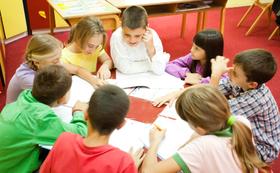Thomas Edison High School, or simply Edison, is a public high school in the Northeast community of Minneapolis, Minnesota, United States. It was named after the American inventor Thomas Alva Edison.
Serving 833 students in grades 9-12, Edison High School ranks in the bottom 50% of all schools in Minnesota for overall test scores (math proficiency is bottom 50%, and reading proficiency is bottom 50%).
The percentage of students achieving proficiency in math is 20-29% (which is lower than the Minnesota state average of 46%). The percentage of students achieving proficiency in reading/language arts is 35-39% (which is lower than the Minnesota state average of 51%).
The student-teacher ratio of 14:1 is higher than the Minnesota state level of 13:1.
Minority enrollment is 73% of the student body (majority Black), which is higher than the Minnesota state average of 39% (majority Black and Hispanic).
Quick Facts (2025-26)
- Grades: 9-12
- Enrollment: 833 students
- Student-Teacher Ratio: 14:1
- Minority Enrollment: 73%
- Graduation Rate: 73% (Btm 50% in MN)
- Overall Testing Rank: Bottom 50%
- Math Proficiency: 20-29% (Btm 50%)
- Reading Proficiency: 35-39% (Btm 50%)
- Science Proficiency: 25-29% (Btm 50%)
- Source: National Center for Education Statistics (NCES), MN Dept. of Education
Top Rankings
Edison High School ranks among the top 20% of public schools in Minnesota for:
Category
Attribute
Diversity
Percent Eligible For Free Lunch
School Overview
Edison High School's student population of 833 students has declined by 17% over five school years.
The teacher population of 58 teachers has declined by 19% over five school years.
Grades Offered
Grades 9-12
(No virtual instruction)
(No virtual instruction)
Total Students
833 students
Gender %
Total Classroom Teachers
58 teachers
Year Founded
1922
Colors
Blue, Gold
School Calendar
School Motto
Belong. Believe. Become.
School Rankings
Edison High School ranks within the bottom 50% of all 1,773 schools in Minnesota (based off of combined math and reading proficiency testing data).
The diversity score of Edison High School is 0.72, which is more than the diversity score at state average of 0.59. The school's diversity has stayed relatively flat over five school years.
Overall Testing Rank
#1401 out of 1773 schools
(Bottom 50%)
(Bottom 50%)
Math Test Scores (% Proficient)
20-29%
46%
Reading/Language Arts Test Scores (% Proficient)
35-39%
51%
Science Test Scores (% Proficient)
25-29%
41%
Student-Teacher Ratio
14:1
13:1
American Indian
4%
2%
Asian
4%
7%
Hispanic
19%
12%
Black
42%
12%
White
27%
61%
Hawaiian
n/a
n/a
Two or more races
4%
6%
All Ethnic Groups
Graduation Rate
73%
84%
Participates in the National School Lunch Program (NSLP)
Yes
Eligible for Free Lunch
65%
36%
Eligible for Reduced Lunch
9%
7%
School Statewide Testing
School District Name
Source: National Center for Education Statistics (NCES), MN Dept. of Education
Profile last updated: 02/09/2025
Frequently Asked Questions
What is Edison High School's ranking?
Edison High School is ranked #1401 out of 1,773 schools, which ranks it among the bottom 50% of public schools in Minnesota.
What schools are Edison High School often compared to?
Edison High Schoolis often viewed alongside schools like Eden Prairie Senior High School by visitors of our site.
What percent of students have achieved state testing proficiency in math and reading?
20-29% of students have achieved math proficiency (compared to the 46% MN state average), while 35-39% of students have achieved reading proficiency (compared to the 51% MN state average).
What is the graduation rate of Edison High School?
The graduation rate of Edison High School is 73%, which is lower than the Minnesota state average of 84%.
How many students attend Edison High School?
833 students attend Edison High School.
What is the racial composition of the student body?
42% of Edison High School students are Black, 27% of students are White, 19% of students are Hispanic, 4% of students are American Indian, 4% of students are Asian, and 4% of students are Two or more races.
What is the student-teacher ratio of Edison High School?
Edison High School has a student ration of 14:1, which is higher than the Minnesota state average of 13:1.
What grades does Edison High School offer ?
Edison High School offers enrollment in grades 9-12 (No virtual instruction).
What school district is Edison High School part of?
Edison High School is part of Minneapolis Public School District.
In what neighborhood is Edison High School located?
Edison High School is located in the Northeast Minneapolis neighborhood of Minneapolis, MN. There are 11 other public schools located in Northeast Minneapolis.
School Reviews
5 10/10/2025
We love Edison. This school actually cares about their kids, and you can see it. They also aren't forcing college down everyon'e's throats and recognize the importance of trade school and apprenticeships. My older adult kid is now off making $60/hour thanks to his teachers who encouraged him to become a unionized electrician! Smart move! He loves it and still thanks his teachers.
Review Edison High School. Reviews should be a few sentences in length. Please include any comments on:
- Quality of academic programs, teachers, and facilities
- Availability of music, art, sports and other extracurricular activities
Recent Articles

School Vouchers: Updated Pros and Cons (2025 Review)
Comprehensive 2025 analysis of school vouchers, weighing benefits and challenges for families, funding, outcomes, and policy directions.

Benefits and Drawbacks of Homework in 2025
Explore updated 2025 insights on homework鈥檚 benefits, drawbacks, mental health impact, best practices, and policy trends in U.S. public schools.

Charter Schools vs Public Schools 2025: Key Differences & Trends
Explore updated 2025 insights comparing charter schools vs public schools, enrollment, academic outcomes, funding, and real-world examples for families and educators.





